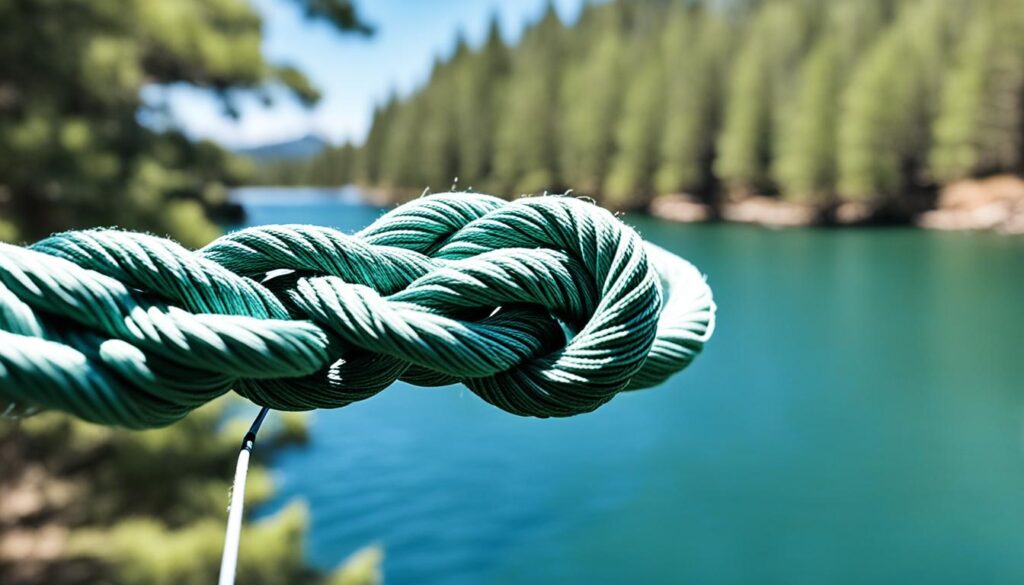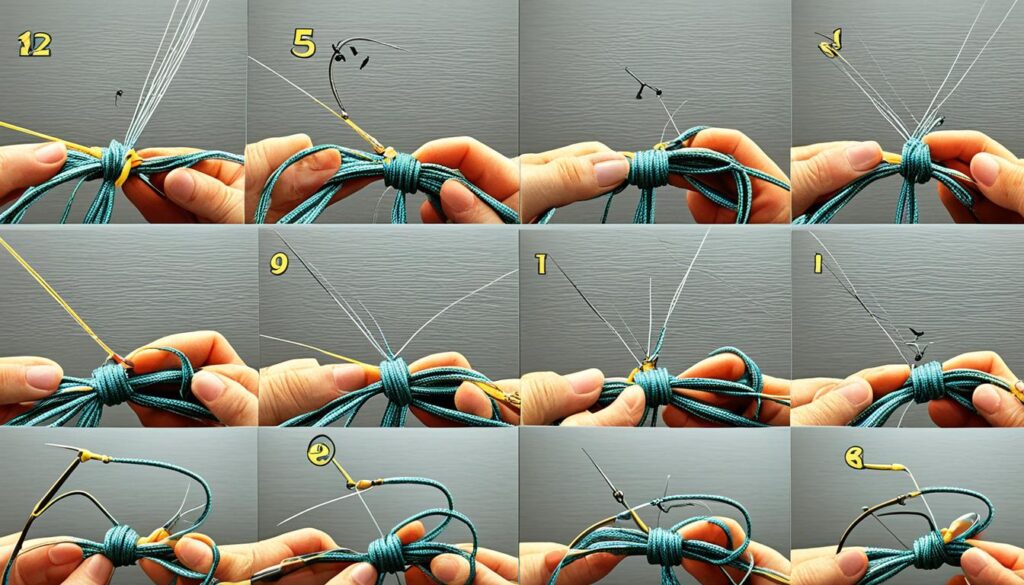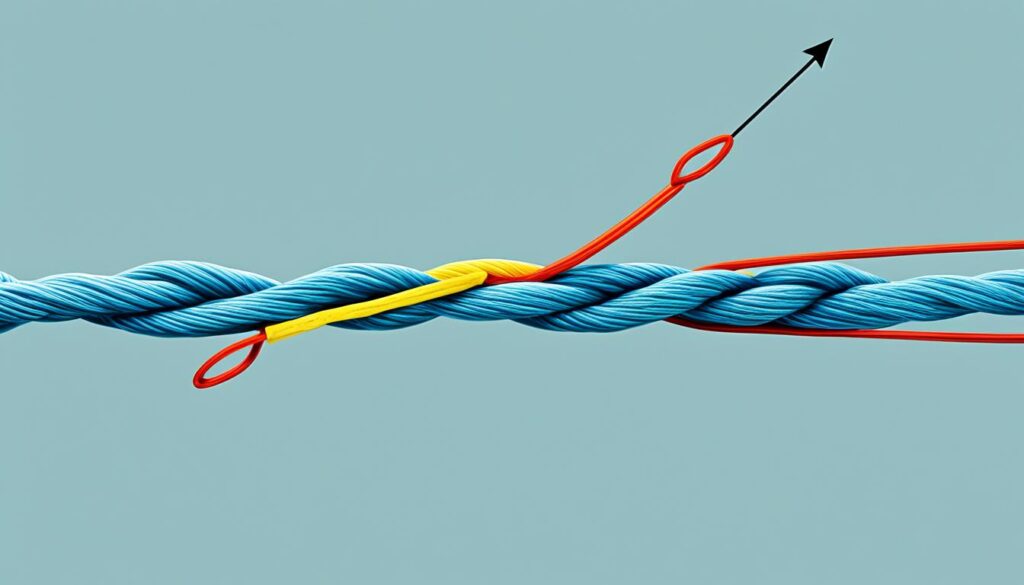For fishers, knowing and using different knots is critical. These knots stop fish from escaping and make the line strong. This guide will teach you all about the slip knot, how to use it in fishing, and the best way to tie it.
Learning to tie a slip knot is important, no matter if you’re a pro or just starting. This knot is great for fishing. It lets you change the loop’s size easily for various hooks or baits. When you know how to tie a slip knot well, your fishing line stays firm, leading to more catches.
Key Takeaways:
- Tying a slip knot is essential for all anglers to prevent the fish from slipping away and maintain a strong fishing line.
- The slip knot is versatile and can be adjusted to fit different hooks or bait sizes.
- By mastering the slip knot, you can increase your chances of a successful fishing experience.
- Practice tying the slip knot regularly to improve your speed and accuracy on the water.
- Enhance your fishing skills by exploring other knot tying techniques.
The Importance of a Good Knot in Fishing
A strong, well-tied knot is key in fishing. It keeps the catch from getting away. This means you won’t miss out on your chance. Also, a good knot keeps the fishing line strong and intact. It stops it from tearing or breaking. Knots help hold the bait and pull in the catch. This makes your fishing trip more likely to succeed.
On the water, the worst is losing a big catch due to a bad knot. A good knot is vital when fishing for bass, trout, or any fish. Its importance is clear for all anglers.
Imagine waiting patiently, casting perfectly, and then hooking a fish. A weak knot means the fish could escape, wasting your hard work. But a strong knot keeps the fish securely hooked until you pull it in.
Moreover, a strong knot is essential to keep the fishing line in good shape. Fishing actions put a lot of stress on the line. A proper knot decreases the chances of the line wearing out or breaking.
A reliable knot not only catches fish and saves your line but also offers peace of mind. Knowing your knot is secure lets you enjoy fishing without equipment worries.
The Role of Knots in Securing the Catch
When a fish bites, it fights to get away. This is where your knot’s strength matters. A strong knot holds tight, making sure the fish can’t escape.
Various fishing methods need different knots. For instance, in dense areas or with large fish, use a strong knot. But, if your fishing requires lively bait, a Loop Knot is best.
Maintaining the Integrity of the Fishing Line
The tension of fishing can weaken your line. A good knot spreads out this strain. It helps avoid line damage or breakage.
With your line’s integrity kept, you have better control over your gear. This is vital when fishing, ensuring you’re ready for any challenge.
So, don’t overlook the power of a good knot on your next fishing trip. Learn and practice tying different knots. Choosing the right knot can make your fishing day more successful.
| Knot | Significance |
|---|---|
| Palomar Knot | Highly recommended for heavy cover and larger species |
| Loop Knot | Enhances bait movement and water action |
| Clinch Knot | Great for lures, hooks, and swivels |
The Basics of Knot Tying
Learning to tie knots is key for anyone who loves fishing. It doesn’t matter if you’re new to the sport or have been fishing for years. Knowing how to tie different knots keeps your line safe, making your fishing trips successful. We’ll go over important terms and why practicing is so crucial.
Understanding the Basic Knot Tying Techniques
Knot tying starts with some simple techniques. These are the building blocks and are handy for many fishing situations.
- Threading the line through the hook’s eye: First, pull the tag end through the hook’s eye. This creates a loop to tie your knot.
- Twisting the line around itself: Then, wrap the tag end around the main line. This helps secure the knot.
- Creating loops: Making loops is also key. It’s how you ensure your knots are strong and don’t fall apart.
The Importance of Understanding the Standing Line and Tag End
Knowing the difference between the standing line and tag end is crucial. The standing line is the main part, and the tag end is what you pull to tighten the knot. This understanding leads to making reliable knots under pressure.
The Significance of Practice in Mastering Knot Tying
Like with any skill, the more you practice, the better you get at tying knots. Tying knots quickly and accurately is important. It means you’re ready for any fishing challenge that may come your way.
Don’t worry if you don’t get it right the first time. Keep at it, and soon, you’ll be tying knots like a pro.
| Knot Tying Techniques | Step-by-Step Knot Tying Guide | Basic Knot Tying Terms |
|---|---|---|
| Threading the line through the hook’s eye | 1. Insert the tag end through the eye of the hook | Standing line – The main part of the fishing line |
| Twisting the line around itself | 2. Twist the tag end around the standing line | Tag end – The loose end of the fishing line |
| Creating loops | 3. Loop the line to create secure knots |
The Palomar Knot
The Palomar Knot is a must-know for all serious fishermen. It is simple and strong, loved by many. It works well with braided lines and for catching big fish. Make sure it’s in your fishing knot repertoire.
Materials Needed for the Palomar Knot
- Fishing line
- Hook or swivel
Here’s how to tie a Palomar Knot step by step:
- Create a loop by doubling the line.
- Tie a loose overhand knot with the doubled line, leaving a large loop.
- Pass the loop over the hook or swivel.
- Tighten the knot by pulling the standing line and the tag end.
The Palomar Knot shines in need of strong, easy knots. It’s great for braided lines due to its strength. This knot also thrives in dense areas. It can pull fish from heavy cover easily.
Best Fishing Conditions for the Palomar Knot
The Palomar Knot works in many fishing settings. It’s perfect for big catch fishing like bass, pike, or catfish. In freshwater or saltwater, it keeps your fish on the line.
Learning the Palomar Knot boosts your fishing game. It gives you peace of mind. Practice it ahead of your fishing trips to get it right even when it’s tough.

| Fish Species | Fishing Technique |
|---|---|
| Bass | Casting lures into heavy cover |
| Pike | Trolling or casting with heavy lines |
| Catfish | Bait fishing in structures |
The Loop Knot
The Loop Knot is handy for fishing. It makes your bait move better in the water. This draws fish in by making it look more alive.
All you need for the Loop Knot is fishing line. With this easy guide, you can learn to tie it:
- Create an overhand knot, leaving some line hanging off.
- Put this line through the hook or lure’s eye.
- Then, loop the line around the main part of the line.
- Finally, pull both ends to secure the knot.
This knot makes bait act more naturally. Fish find this movement hard to resist, so your catch rate might go up.
The Loop Knot is also very strong. It’s designed not to come loose easily. So, you can relax knowing your knot is secure.
| Benefits of the Loop Knot |
|---|
| Improves bait movement |
| Enhances attractiveness to fish |
| Provides strength and reliability |
Adding the Loop Knot to your skills is smart. Anglers like it because it’s easy and works well for everyone.
Testimonial
“Ever since I started using the Loop Knot, my fishing success has skyrocketed! The improved bait movement and reliability of this knot have made a significant difference in my catches. I highly recommend learning how to tie the Loop Knot.”

The Clinch Knot
The Clinch Knot is a must-know for all anglers. It’s perfect for securing lures, hooks, or swivels. This strong knot improves your fishing by working well in different conditions.
To make a Clinch Knot, gather a fishing line and your hook or lure. Below are the steps to follow:
- Put the line through the hook, leaving some extra line for the next step.
- Wind the extra line around the longer part 5-7 times, moving away from the hook.
- Put the end through the loop made next to the hook’s eye, creating a new loop.
- Wet the knot, then draw the main line tight to snug up the knot. Make sure it holds well.
This knot works well in many fishing environments. It’s great for catching bass in rivers or facing big ocean fish. When you go fishing, always use a confident Clinch Knot. This will make your day on the water successful.
FAQ
Why are good knots important in fishing?
Good knots keep your catch from slipping away. They also stop the fishing line from breaking or fraying.
What are the basic techniques in knot tying for fishing?
To start, thread the line through the hook’s eye. Then, twist the line around itself. Finally, create loops to secure the knot.
Why is practicing knot tying important?
Frequent knot tying practice boosts your skills while fishing. It makes you quicker, more precise, and effective on the water.
What is the Palomar Knot used for, and what materials do I need to tie it?
The Palomar Knot is great for fishing with braided lines, heavy cover, or for big fish. You need a fishing line, a hook, or a swivel to tie it.
How do I tie a Palomar Knot?
First, create a loop in the line. Then, tie a loose overhand knot. Pass the loop over the hook, and tighten the knot securely.
What is the Loop Knot used for, and what materials do I need to tie it?
The Loop Knot boosts bait or lure movement in the water. It attracts fish better. All you need is a fishing line to tie it.
How do I tie a Loop Knot?
Start with a simple overhand knot. Next, pass the tag end through the hook’s eye. Wrap the tag end around the line. Finally, pull and tighten the knot.
What is the Clinch Knot used for, and what materials do I need to tie it?
The Clinch Knot safely connects lures, hooks, and swivels. It works well in many fishing situations. You will need a fishing line and a hook or lure to tie it.
How do I tie a Clinch Knot?
Thread the line through the hook’s eye first. Then, wrap the line around itself. Pass the end through the loop close to the hook’s eye. Finally, tighten the knot.
